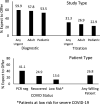The impact of the COVID-19 pandemic on sleep medicine practices
- PMID: 32964828
- PMCID: PMC7849634
- DOI: 10.5664/jcsm.8830
The impact of the COVID-19 pandemic on sleep medicine practices
Abstract
Study objectives: The COVID-19 pandemic required sleep centers to consider and implement infection control strategies to mitigate viral transmission to patients and staff. Our aim was to assess measures taken by sleep centers due to the COVID-19 pandemic and plans surrounding reinstatement of sleep services.
Methods: We distributed an anonymous online survey to health care providers in sleep medicine on April 29, 2020. From responders, we identified a subset of unique centers by region and demographic variables.
Results: We obtained 379 individual responses, which represented 297 unique centers. A total of 93.6% of unique centers reported stopping all or nearly all sleep testing of at least one type, without significant differences between adult and pediatric labs, geographic region, or surrounding population density. By contrast, a greater proportion of respondents continued home sleep apnea testing services. A total of 60.3% reduced home sleep apnea testing volume by at least 90%, compared to 90.4% that reduced in-laboratory testing by at least 90%. Respondents acknowledged that they implemented a wide variety of mitigation strategies. While no respondents reported virtual visits to be ≥ 25% of clinical visits prior to the pandemic, more than half (51.9%) anticipated maintaining ≥ 25% virtual visits after the pandemic.
Conclusions: Among surveyed sleep centers, the vast majority reported near-cessation of in-laboratory sleep studies, while a smaller proportion reported reductions in home sleep apnea tests. A large increase in the use of telemedicine was reported, with the majority of respondents expecting the use of telehealth to endure in the future.
Keywords: COVID-19; polysomnography; sleep centers; telemedicine.
© 2021 American Academy of Sleep Medicine.
Conflict of interest statement
All authors have seen and approved the manuscript. Work for this study was performed at Baystate Medical Center, Springfield, MA. The authors report no conflicts of interest.
Figures





References
-
- Simonds AK, Hanak A, Chatwin M, et al. . Evaluation of droplet dispersion during non-invasive ventilation, oxygen therapy, nebuliser treatment and chest physiotherapy in clinical practice: implications for management of pandemic influenza and other airborne infections. Health Technol Assess. 2010;14(46):131–172. 10.3310/hta14460-02 - DOI - PubMed
-
- World Health Organization . Infection prevention and control during health care when novel coronavirus (nCoV) infection is suspected: Interim Guidance. https://www.who.int/publications/i/item/infection-prevention-and-control...; 2020. Published March 19, 2020. Accessed September 29, 2020.
MeSH terms
LinkOut - more resources
Full Text Sources
Other Literature Sources
Medical
Miscellaneous

